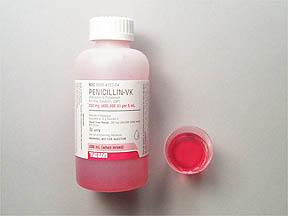
Penicillin V Potassium Coupons & Savings Card – Discount Prices from $2.00
Penicillin is an antibiotic used to treat and prevent a wide variety of bacterial infections. It works by stopping the growth of bacteria. This antibiotic treats only bacterial infections. It will not work for viral infections (such as common cold, flu). Using any antibiotic when it is not needed can cause it to not work for future infections.
Our coupons are free to use. Before paying, show the pharmacist your Penicillin V Potassium savings card to get your free discount. Use our filters below to edit the prescription box to match your needs. The Penicillin V Potassium prices will update based on your prescription needs. Above our Penicillin V Potassium coupons, you can change your location to see pharmacy prices and costs in other areas. We're here to help you buy Penicillin V Potassium at the lowest price with our prescription discount card.
My prescription
Edit
100ML of 250MG/5ML, Penicillin V Potassium (1 Bottle)
Select pharmacy

CVS
$19.40
COUPON PRICE
Walgreens
$2.00
COUPON PRICE
Albertsons
$7.02
COUPON PRICE
Walmart
$8.91
COUPON PRICEPenicillin V Potassium savings card
Show this card to your pharmacist
Walgreens
$2.00
BIN
ID
PCN
GRP
019876
LHC5EAEC60
CHIPPO
LHX
Powered by
Penicillin is an antibiotic used to treat and prevent a wide variety of bacterial infections. It works by stopping the growth of bacteria. This antibiotic treats only bacterial infections. It will not work for viral infections (such as common cold, flu). Using any antibiotic when it is not needed can cause it to not work for future infections.
Our coupons are free to use. Before paying, show the pharmacist your Penicillin V Potassium savings card to get your free discount. Use our filters below to edit the prescription box to match your needs. The Penicillin V Potassium prices will update based on your prescription needs. Above our Penicillin V Potassium coupons, you can change your location to see pharmacy prices and costs in other areas. We're here to help you buy Penicillin V Potassium at the lowest price with our prescription discount card.
Our coupons are free to use. Before paying, show the pharmacist your Penicillin V Potassium savings card to get your free discount. Use our filters below to edit the prescription box to match your needs. The Penicillin V Potassium prices will update based on your prescription needs. Above our Penicillin V Potassium coupons, you can change your location to see pharmacy prices and costs in other areas. We're here to help you buy Penicillin V Potassium at the lowest price with our prescription discount card.
